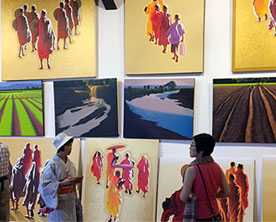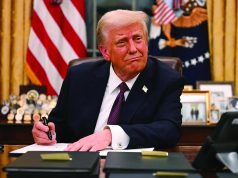In the days of US sanctions and closed economy, investment opportunities are nil and people have to hoard cash. Investment is in real estate, precious stones and gold. Keeping these possessions was relevant at that time as these does not deteriorate and depreciate in value. Cash even became useless when demonetization happened. Fast forward, the lifting of sanctions and the opening of the economy integrated the country into the global market opening up opportunities. Investments energized not only Yangon and Mandalay but also key regional cities who became hubs of commercial activities. As the economy grow, the emerging middle class has triggered increased consumer spending. Malls started to appear and usher in a new lifestyle. The new way of life sweeping the country was complemented by the now ubiquitous smartphones and social media sites that connects people not only in Myanmar but to the rest of the world.
Small and medium enterprises mushroomed, from retailing, tourismrelated businesses and even some notorious multi-level marketing companies. There in a surge in investments in the traditional instruments – real estate, precious gems and gold. Aside from these, new opportunities to earn and invest also became available.
The financial sector was among the first to upgrade their products and services providing not only easy access but also a good facility for safekeeping and higher yield. Insurance is gradually catching up with more relevant products aligned with the needs of the upwardly mobile young Myanmar professionals. Of course, there is a stock market for those who are risk tolerant and financially savvy.
The demand for art
Real estate remains to be a favorite investment. More than a hundred high-rise condominiums and mix-use buildings are being built and more are planned for construction targeting not only expats but the emerging middle class. Office spaces for companies locating in the country is projected to increase despite the slowdown in the economy.
One of the elements of contemporary buildings are art works which includes paintings, sculptures and installation arts. Art is an indispensable fixture as it gives ‘soul’ to the structures. Without art, a building will just be an unsightly slab of rocks and cement.
C o m p a n i e s , p a r t i c u l a r l y t h e multinationals, invest in arts. They buy and collect artworks to display and make their workplaces a nice place. Art appreciation rubs on not only to executives of these companies but also to individuals who work inside these buildings where art pieces are everywhere. Counting the floors and the units of a newly-constructed building in Yangon will give us an idea on the number of art works needed.
Art pieces are not just bought to fill the walls of an office or a condo unit. It is not just painting for the sake of having a picture fixed on the wall. Art works inspire and create the ideal environment in a place. It also reflects the character of the company, and its occupants, and finding the best pieces is of paramount importance. With the best, the supply is finite. An artist can only do so much pieces in a lifetime. As more buyers clamor for an artist’s works, the price surges. This makes art as good investment instrument. An art piece can be enjoyed and at the same time can be sold in the future for a premium. Individuals owning a condo unit can include art works as part of their bling in the unit. They provide income to the artists, support the art community and promote culture.
The supply:
Myanmar art community Myanmar has a lively art community. In Yangon there are more than 50 galleries, not to include those in Mandalay which is considered as the cultural capital of the country. Art exhibits are frequent allowing collectors and even ordinary people to gaze and appreciate art for free.
There is a long list of Myanmar masters whose work have become popular not only locally but even in foreign countries. These includes names like Lun Gywe, whose works in oil and watercolor are depiction of daily life in Myanmar; Paw Oo Thet, another master using oil; Win Pe Myint, who became famous for still life paintings; abstract painter Aung Aoe; and Aung Myint, who does not only paint in oil but also do installation pieces.
A lot of emerging artists are showing potentials for becoming masters in the future. These include names like Htein Linn, Min Wai Aung, Ba Nyan, Ngwe Gaing and Ba Kyi, to name a few. Most of them have done exhibits abroad are widely acclaimed in international circles. Appreciating and investing in art One has to appreciate art before becoming an art investor or collector. Developing the love for art can be acquired and nurtured. The first step, just like any hobby, is to set aside time for art appreciation. Educating oneself on the various media, styles of artists and other dynamics of art appreciation can be done in simple ways.
Visiting galleries is a starter. A lot are located in the downtown, particularly the stretch of Pansodan Street. Bogyoke Zay is also a good place to start as there are several galleries inside it, with displays at the main entrance. While in the galleries asking questions can be of great help to learn more about a certain artist and his style.
There are also art magazines about local artists and their works. The internet is overflowing with information about Myanmar artists and the art community. Viewing exhibits is another activity that will introduce you to other art lovers, from where one can build a network. Investing in art can be considered safe because you can enjoy the work and keep it as long as you wanted it. Parting with an art piece by selling is an option if one needs cash or when the piece has increased its value. If the artist is well known the appreciation in the value of his works will give you good returns to your investment. The flipside is when art piece is not appreciating, but then it will leave you with something you can display.
In buying you can select works of the masters. This may require a bigger sum, but you are sure that it will have a good price when you resell it. One tip to remember is to make sure that you but from reliable sources only as there are fakes also that will burn your money. Owning a fake may also make you a pariah in the art community.
Another way is to acquire works of young artists who are starting to make names for themselves. Their works will not require investment, but as they grow their reputation, the value of their works increases. You should also keep in touch with the market. Just like the farmer looking out for this crop, or the stockbroker looking at the price of his stocks, the art investor should also keep in touch with the market. You can check on the value of your art pieces from galleries and assess the current value of your collection. Final advice, as always in business, the right time to act is now.










